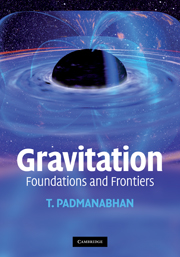Book contents
- Frontmatter
- Contents
- List of exercises
- List of projects
- Preface
- How to use this book
- 1 Special relativity
- 2 Scalar and electromagnetic fields in special relativity
- 3 Gravity and spacetime geometry: the inescapable connection
- 4 Metric tensor, geodesics and covariant derivative
- 5 Curvature of spacetime
- 6 Einstein's field equations and gravitational dynamics
- 7 Spherically symmetric geometry
- 8 Black holes
- 9 Gravitational waves
- 10 Relativistic cosmology
- 11 Differential forms and exterior calculus
- 12 Hamiltonian structure of general relativity
- 13 Evolution of cosmological perturbations
- 14 Quantum field theory in curved spacetime
- 15 Gravity in higher and lower dimensions
- 16 Gravity as an emergent phenomenon
- Notes
- Index
12 - Hamiltonian structure of general relativity
Published online by Cambridge University Press: 05 June 2012
- Frontmatter
- Contents
- List of exercises
- List of projects
- Preface
- How to use this book
- 1 Special relativity
- 2 Scalar and electromagnetic fields in special relativity
- 3 Gravity and spacetime geometry: the inescapable connection
- 4 Metric tensor, geodesics and covariant derivative
- 5 Curvature of spacetime
- 6 Einstein's field equations and gravitational dynamics
- 7 Spherically symmetric geometry
- 8 Black holes
- 9 Gravitational waves
- 10 Relativistic cosmology
- 11 Differential forms and exterior calculus
- 12 Hamiltonian structure of general relativity
- 13 Evolution of cosmological perturbations
- 14 Quantum field theory in curved spacetime
- 15 Gravity in higher and lower dimensions
- 16 Gravity as an emergent phenomenon
- Notes
- Index
Summary
Introduction
We obtained Einstein's equations in Chapter 6 from an action principle in which we varied the four-dimensional metric tensor gab. The resulting equation, Gab = kTab, is generally covariant in the spacetime. We also described in Section 6.3 several peculiar features of Einstein's equations. In particular, we noticed the following. (i) The time derivatives of g00 and g0α do not occur in any of the equations. (ii) No second time derivatives of gαβ occur in the time–time or space–time components of Einstein's equations. These equations contain only the first time derivatives of gαβ. (iii) Only the space–space part of Einstein's equations involves the second time derivatives of gαβ.
These peculiarities introduce several complications when we attempt to study Einstein's theory as describing the evolution of some well defined dynamical variables. It is clear from the above properties that one cannot treat all the components of the metric tensor on an equal footing; the real dynamics is essentially contained in the evolution of gαβ. At the same time, the generally covariant description treats the metric as a single entity which allows for a nice geometrical interpretation of Einstein's theory. The question arises as to whether one can maintain the geometrical structure of the theory and yet perform a split of Einstein's equations, along with the dynamical variables, into space and time. We shall now describe how this can be achieved.
- Type
- Chapter
- Information
- GravitationFoundations and Frontiers, pp. 530 - 559Publisher: Cambridge University PressPrint publication year: 2010



